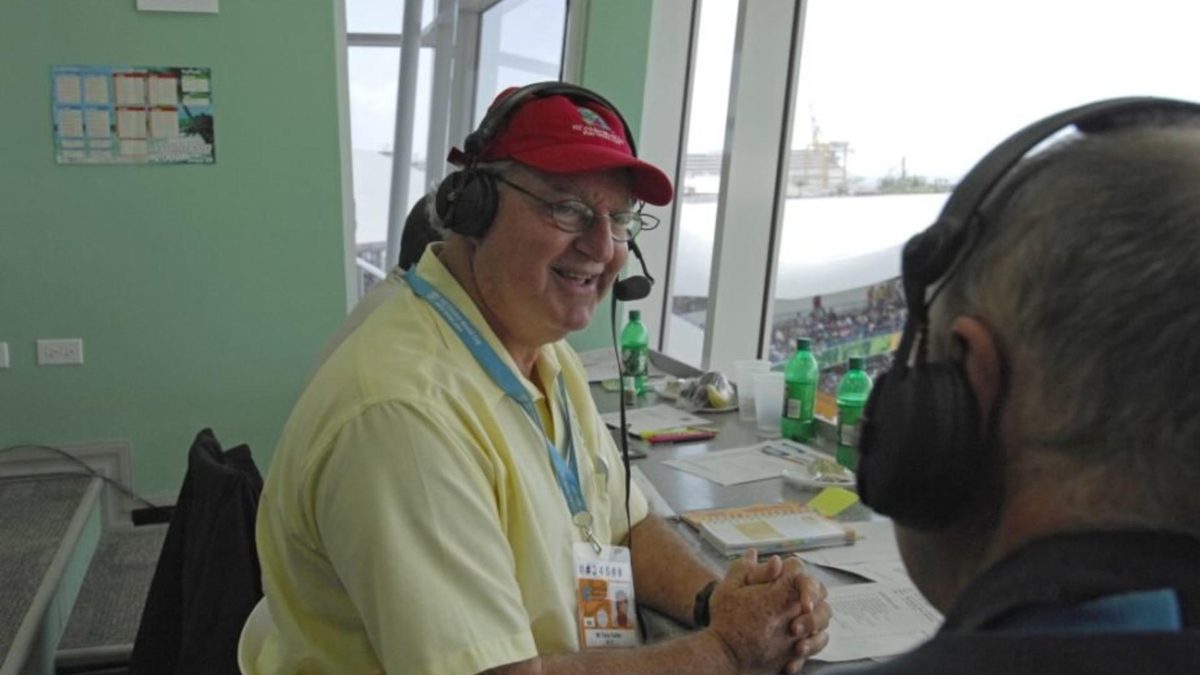
The West Indies play an ICC World XI at Lord’s on May 31 to aid ground repairs at various Windies grounds following hurricanes last year, so we delved into the archives for this piece from the late, great Tony Cozier, who looks back on fifty years of watching West Indies at Lord’s.
This article was first published in issue 6 of The Nightwatchman in 2014. Buy a hard copy of this article today.
First published in 2014
I hadn’t come across George Medford since we were together at school in Barbados. Quite by chance, traversing Lord’s during the 1966 Test, I spotted him among a group of happy West Indians in the bar under the Grand Stand. Garry Sobers had just completed the match-saving hundred he still rates as his finest, and his cousin, David Holford, wasn’t far away from his own on the way to their unbroken stand of 274.
His immediate greeting was along the lines of, “remember I told you we’d one day make it to Lord’s.” I pointed out that our schoolboys’ dream was to “make it” as West Indies players. But here we were – a spectator from Shoreditch, and a journalist. He had settled in London on joining the post-war exodus from the Caribbean, and now timed his week off work with the Test at the ground we had always referred to as “The Mecca”. And I was covering the Test series for papers back home.
It mattered to neither of us. By now, we were settled into our careers, George in a senior position at the British Post Office, me reporting on West Indies teams wherever they went.
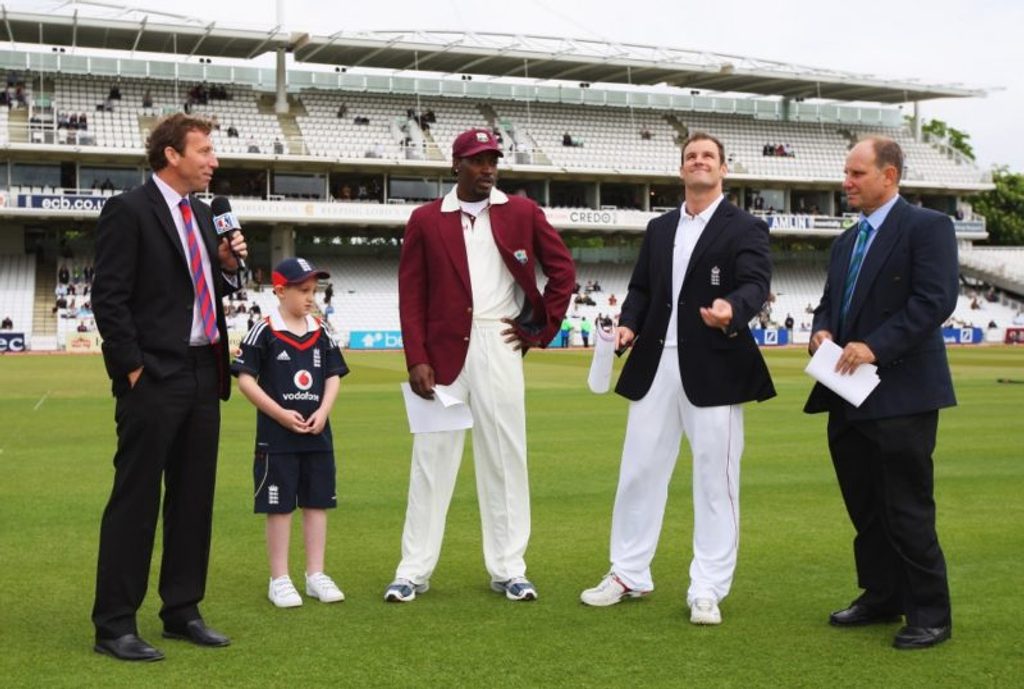 The coin toss prior to the first Test in 2009 at Lord’s.
The coin toss prior to the first Test in 2009 at Lord’s.
As schoolboys in Barbados, our impressions of Lord’s had been formed through John Arlott’s lyrical radio commentaries. There was no need to describe it as the home of cricket; to our fanatical imaginations, it materalised as some cricketing Valhalla that awaited aspiring West Indian cricketers. Ignoring our limited talent, George and I were convinced that we would eventually be among them.
Instead, we had to be satisfied with playing at various make-believe Lord’s. Our school house matches were at “Lord’s”. So were pick-up games in someone’s backyard, in the road, in Subbuteo cricket. You batted as Worrell or Weekes, bowled as Ramadhin or Valentine, but, wherever the venue, it was usually “Lord’s”.
For George, a visit to the authentic Lord’s, the one off the St John’s Wood Road, was a priority on his arrival in England. He made it to the memorable 1963 Test when Colin Cowdrey appeared down the famous Pavilion steps, broken left arm in plaster, to occupy the non-striker’s end while David Allen survived the last two balls from a rampant Wes Hall.
George admitted that he shed a tear on entering the ground for the first time. The 1963 Test was also my first sighting of the place we knew through Arlott’s unmistakable descriptions; now as a skeptical journalist, it somehow didn’t have such an effect on my emotions, as grand as it was.
In Barbados, as in the other colonies, we had grown up with all things British firmly etched on our consciousness. Our cinemas featured Pathé News clips of the Opening of Parliament, Trooping the Colour and other ceremonial occasions. Our history books detailed famous British battles and famous leaders. Shakespeare, Wordsworth, Keats, Byron and the perplexing Chaucer were all on the English Literature syllabus. We looked forward to fireworks on Guy Fawkes night.
We plodded through as best we could to “O” and “A” level passes. We more readily related to colonialism’s most admired legacy, the intricate game of cricket. Introduced by British troops, it quickly gained wide popularity; West Indians, it turned out, were quite good at it. Teams had toured England since the turn of the 20th century, and vice versa.
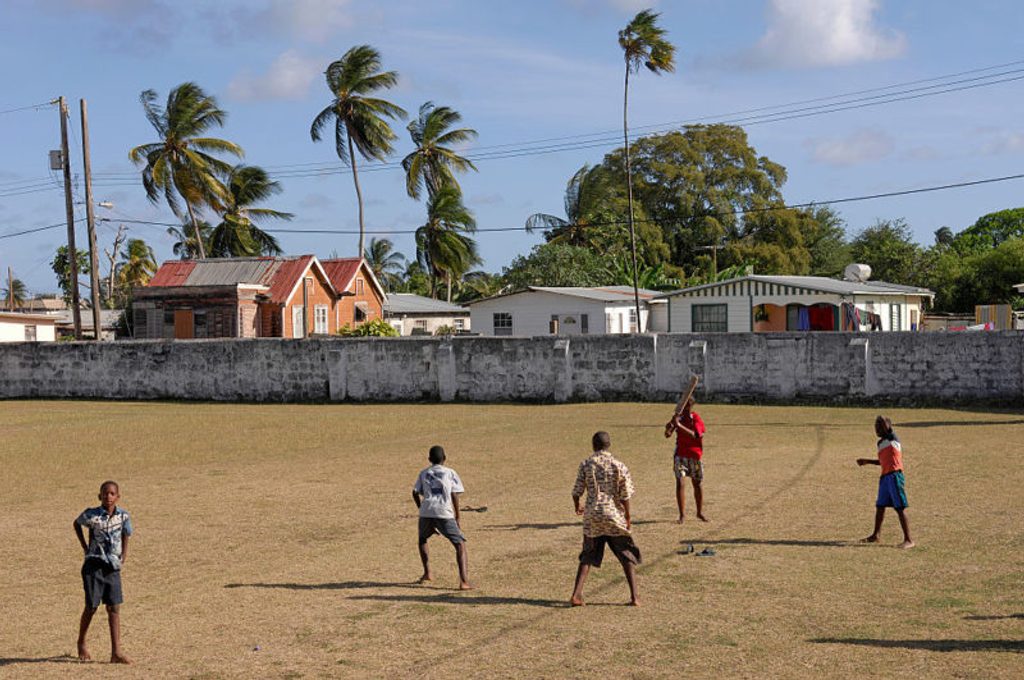 Local boys practicing at the Empire Cricket Club, Bank Hall, Barbados, April 2007
Local boys practicing at the Empire Cricket Club, Bank Hall, Barbados, April 2007
In 1926, the West Indies were elevated to Test status by the Imperial Cricket Conference (“Imperial” wasn’t changed to the more appropriate “International” until 1965). It wasn’t until 1950 that they finally defeated England in a Test in England – and at Lord’s to boot.
I was too young at the time to fully appreciate its overall significance (I was ten) but I must have sensed the universal euphoria that it generated. Everywhere, motorcades greeted the team on its return. Laudatory speeches were made by Very Important People. Soon Lord Beginner’s calypso, “Cricket, Lovely Cricket, at Lord’s where I saw it,” had become the first anthem of West Indies cricket.
My father reported on that tour for Caribbean papers; he would later explain what the result meant to West Indians at home and, not least, to those early immigrants, struggling to make ends meet in the land they had come to believe offered them the key to a better life.
A few months after the 1950 team returned home, the captain John Goddard, an old boy, turned up at our school to speak about the triumph. Just recently, Sir Everton Weekes – now 89 and, along with Ramadhin, one of only two surviving members of the team – told me in an interview: “I get fairly emotional when I talk about that 1950 tour.” It is a sentiment shared by all West Indians who appreciate their history.
To our fanatical imaginations, Lord’s materialised as some cricketing Valhalla that awaited aspiring West Indian cricketers
As the British West Indies emerged from colonialism into a self-governing federation in 1958, Sir Grantley Adams, the federal Prime Minister, spelt out to us enquiring sixth formers how Lord’s 1950 rated highly on the thrust towards nationhood. CLR James subsequently further put it into context in his classic, Beyond a Boundary.
West Indians longed for symbols and heroes of their own, Adams reasoned. They were essential for the self-confidence needed to move from dependence on Britain to managing our own affairs. Even as one of the political leaders who led the case for the transition, he conceded that our cricket and our cricketers were better placed than them to provide such a boost.
Further confirmation of his thesis was not long in coming. Frank Worrell was belatedly appointed the first black captain in 1960 and under him, the West Indies helped revive the flagging status of Test cricket with their uniquely ebullient approach in Australia and England.
Along with Weekes and Clyde Walcott, Worrell had been one of the Three Ws so critical to the West Indies’ development into a genuine force in the 1950s, returning in the twilight of his career as the father figure to a group of emerging young stars. On his retirement following the 1963 England tour, his role was recognised with a knighthood. Weekes and Walcott subsequently received the same accolade.
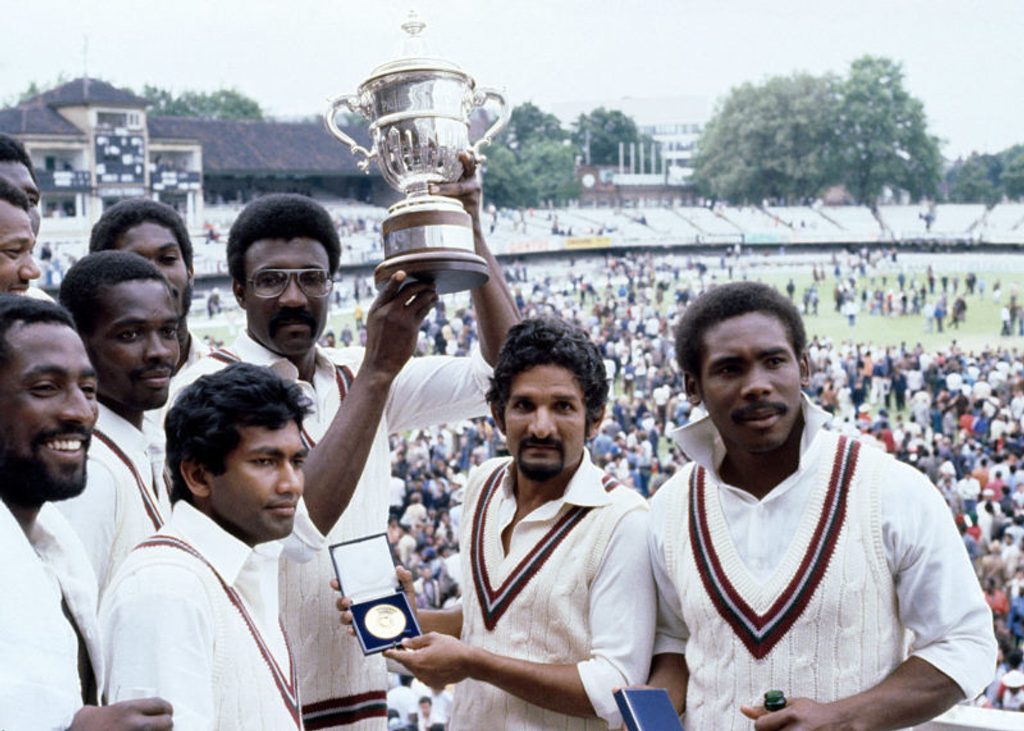 West Indies captain Clive Lloyd holds the trophy after winning the 1979 World Cup Final at Lord’s
West Indies captain Clive Lloyd holds the trophy after winning the 1979 World Cup Final at Lord’s
Worrell’s successor, his brilliant protégé, Sobers, from a working-class suburb of Bridgetown, became generally recognised as the finest all-rounder the game has known. He too was knighted, in 1975, by Queen Elizabeth II in a public ceremony on the site of the old British garrison. In 1998, he was installed as Barbados’s only living national hero. Later these honours were also bestowed on Viv Richards by a grateful government in his native Antigua.
The breakthrough to such developments was Lord’s 1950. The black-and-white photo of a dozen celebrating West Indians skipping across the Lord’s outfield in the wake of the guitar-strumming calypsonian Lord Kitchener remains one of the iconic images of West Indies cricket.
Jeffrey Stollmeyer, a widely respected white Trinidadian from a landowning family, opened the innings in the Lord’s Test in 1939 as an 18-year-old schoolboy. He returned in 1950. Later captain, selector and president of the board, he was beguiled by the grandeur of Lord’s.
“I especially remember entering the Long Room in the Pavilion through which one felt one ought to tiptoe,” he wrote. “Any cricketer who walks on to the hallowed turf at Lord’s for the first time and does not feel a special thrill must be made of stone, not flesh and blood.
The evidence is strong that West Indies players from circumstances far less privileged than Stollmeyer’s – in other words, the majority – also felt that “special thrill” entering “the hallowed turf”, even from a Pavilion typifying the strictly demarcated British class system that was anathema to the purpose of independence.
The roll call of those who left indelible marks on Lord’s scorecards reads like a Who’s Who of West Indies cricket.
*1939: George Headley’s century in each innings
*1950: Clyde Walcott’s 168 not out and the 18 wickets taken by Sonny Ramadhin and Alf Valentine
*1963: Basil Butcher’s 133 in a total of 229 and Wes Hall’s two-and-a-half-hour spell of fast bowling
*1966: Sobers’ unbeaten 163
*1973: Sobers’ and Kanhai’s farewell hundreds in England
*1975: Clive Lloyd’s 102 in the inaugural World Cup final
*1976: Roy Fredericks’ 138 and Andy Roberts’ 10 wickets
*1979: Viv Richards’ unbeaten 138, Collis King’s 86 and Joel Garner’s 5-38 in the second World Cup final
*1980: Desmond Haynes’ 184, his maiden Test hundred
*1984: Gordon Greenidge’s 214 in a seemingly-impossible victory charge
*1984 and 1988: Malcolm Marshall’s 18 wickets in two Tests
*1991: Carl Hooper’s 111
In 11 Lord’s Tests between 1950 and 1991, the West Indies lost just one, in 1957. Since then, the ratio is the other way round, five losses, one draw. Only the enduring Shivnarine Chanderpaul’s unbeaten double of 127 and 97 in 2004 and 87 and 91 in 2012 can be included on the earlier honours roll.
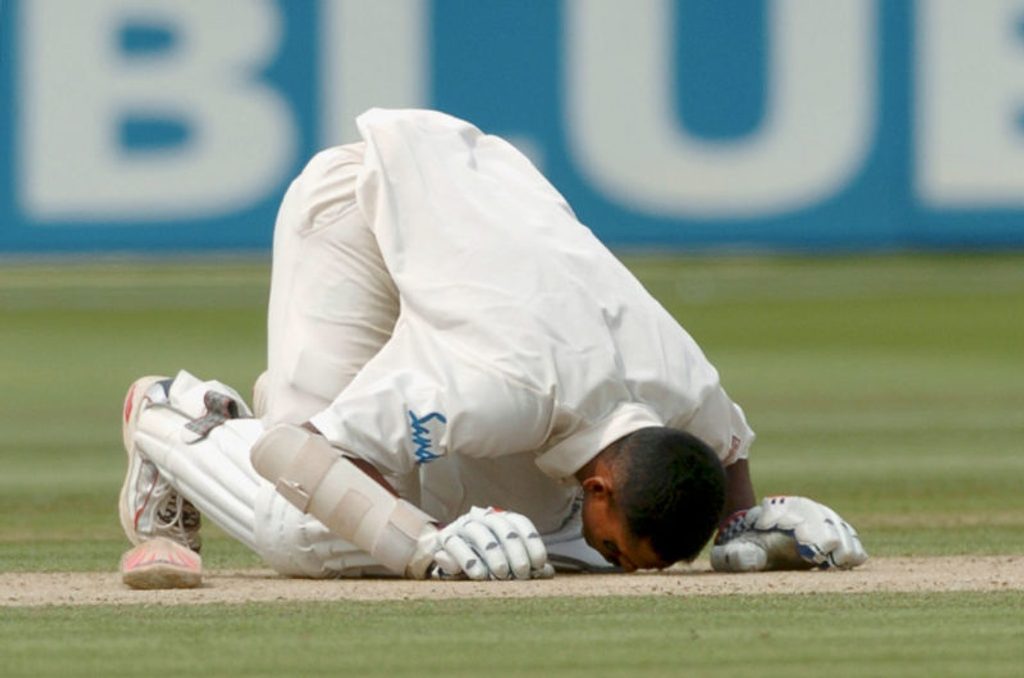 Shivnarine Chanderpaul kissing the pitch after reaching his century at Lords in 2004
Shivnarine Chanderpaul kissing the pitch after reaching his century at Lords in 2004
Such discrepancy presents a plausible theory that goes beyond Stollmeyer’s “special thrill”; success was equally down to the rousing support the West Indies received from their relocated kith and kin in the stands.
As reporter and then commentator on Test Match Special, I’ve been on duty at every West Indies Test and World Cup appearance at Lord’s from 1963 to the present. Memories of a dozen or so energised West Indians rushing out to the middle to hail Sobers on arriving at his hundred in 1966 and of thousands jumping, somersaulting and creating a joyful ruction on the edge of the boundary ropes as Lloyd and Richards dominated their respective World Cup victories remain the most vivid out of the mass of others.
There was also the contrasting despondency of players and supporters following the complacency-driven loss to India in the 1983 World Cup final; Joel Garner said he was so upset, he left immediately afterwards to continue his season with Somerset and did not speak to any of his West Indies team-mates “for months”.
Between 1980 and 1995, the West Indies did not lose a Test series against anyone, and against England they twice won 5-0. It was a shock when they even lost a single Test.
We were realistic enough to know that such supremacy wouldn’t last forever. What we didn’t – couldn’t – suspect was that the end would be so abrupt.
I was invited to ring the bell from the member’s bar balcony. “Boy, you really done good,” he quipped.
It directly coincided with the sharp decline in support at Lord’s and the Oval, the two London grounds that had been invariably populated by thousands of their countrymen bellowing their encouragement in their distinctive but varied island accents.
The change reflected the gradual disconnect between the children and grandchildren of the original immigrants and the Caribbean. Third- and fourth-generation Afro-Caribbeans, as they came be to be called, gravitated to sports such as football and track and field, whose black stars represented England. Lord’s was not part of their vocabulary.
Further disincentives for those still wanting to cheer on West Indies were the hefty entrance fee to Tests and the introduction of online ticket sales that precluded friends from gathering together in their favourite area, always a requirement at any cricket match.
In over 50 years covering West Indies Tests, I find it impossible to differentiate between 20, even 30, that brought the most satisfaction; yet there is one that stands alone as the saddest. It was at Lord’s in 2000, a date of special significance as the 50th anniversary of the 1950 victory and the 100th anniversary of the West Indies’ first match at the ground on their first tour of England in 1900. Five members of their 1950 team (Weekes, Walcott, Ramadhin, Valentine and Allan Rae) were invited guests, as were seven of England’s.
Midway through the second day, a Friday, the West Indies were seemingly proceeding to a repeat of the 1950 outcome; they had won the first Test by an innings and 93 runs and now secured a first-innings lead of 133 as Curtly Ambrose and Courtney Walsh rolled England for 134.
The match turned on its head in the next 26.4 overs as the West Indies crumbled to 54 all out. It was not difficult to imagine the shock among those from the 1950 match, observing in disbelief from the Pavilion. The next day, manfully as Ambrose and Walsh tried to retrieve the situation, England secured victory by two wickets. It was a gut-wrenching anti-climax.
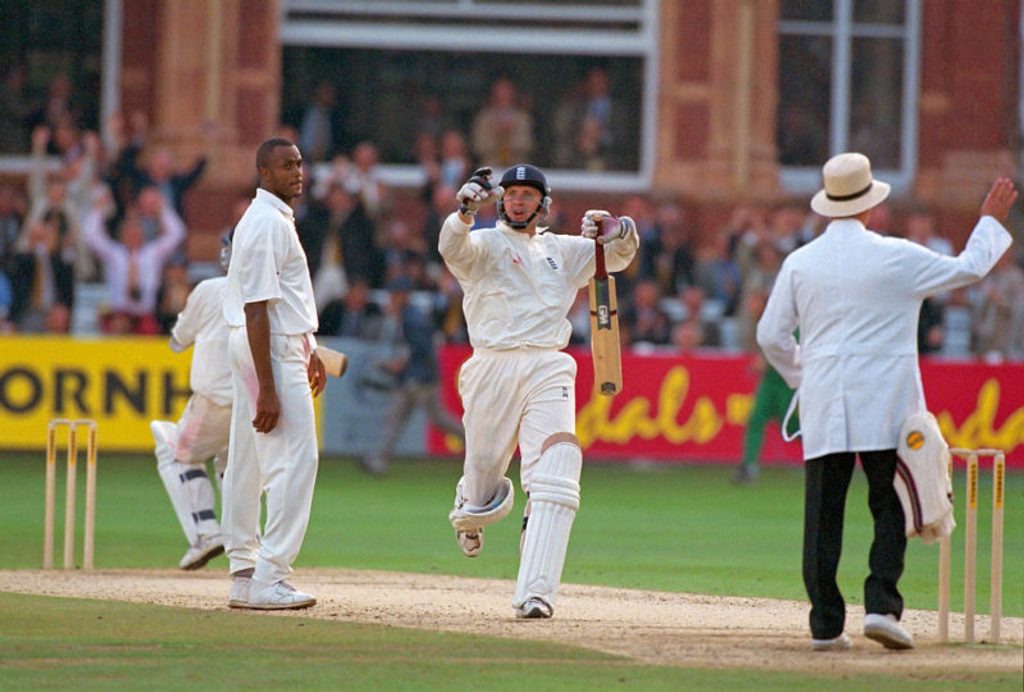 Dominic Cork celebrates hitting the winning runs off Courtney Walsh at Lords in 2000
Dominic Cork celebrates hitting the winning runs off Courtney Walsh at Lords in 2000
That night, George Medford called, crestfallen, to say he would not be watching another West Indies Test. Not even at Lord’s? Especially not at Lord’s, he replied.
He kept to his word until I persuaded him to be my guest for the 2012 Test following MCC’s decision that year to make me an honorary life member (presumably on the grounds of longevity). He was most impressed when I was invited to ring the bell from the member’s bar balcony denoting 10 minutes before the start of play. “Boy, you really done good,” he quipped.
West Indies lost again but they put up a much stronger showing than in 2000. I’m sure George treasured his first experience of the Lord’s Pavilion. It was to be his last.
A year later, I learned that he had passed on to the Lord’s in the sky where, no doubt, he’s with his mates from under the Grand Stand recalling happy times gone by.
The West Indies will play an ICC World XI at Lord’s on May 31 with commentary on Wisden.com courtesy of Guerrilla Cricket.








